CBSE Political Science Sample Papers and Syllabus for Class 12th
Section A
Section – A consists of 24 questions. Attempt any 20 questions from this section. The first attempted 20 questions would be evaluated.
1. The structure of bilobed anther consists of
- 2 thecae, 2 sporangia
- 4 thecae, 4 sporangia
- 4 thecae, 2 sporangia
- 2 thecae, 4 sporangia
The correct answer is 2 thecae, 4 sporangia
2. In the figure of anatropous ovule given below, choose the correct option for the characteristic distribution of cells within the typical embryo sac
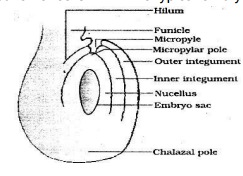
| Number of cells at chalazal end | Number of cells at micropylar end | Number of nuclei left in central cell | |
|---|---|---|---|
| A | 3 | 2 | 3 |
| B | 3 | 3 | 2 |
| C | 2 | 3 | 3 |
| D | 2 | 2 | 4 |
The correct answer is B. 3,3,2
3. The coconut water from tender coconut is
- cellular endosperm.
- free nuclear endosperm.
- both cellular and nuclear endosperm.
- free nuclear embryo.
The correct answer is free nuclear endosperm.
4. Pollen grains are well preserved as fossils because of presence of
- sporopollenin
- cellulose
- lignocellulose
- pectocellulose
The correct answer is sporopollenin
5. Which of the following statements are true related to Seed X and Y?
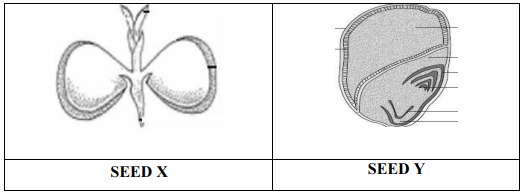
- Seed X is dicot and endospermic or albuminous.
- Seed X is dicot and non-endospermic or non-albuminous.
- Seed Y is monocot and endospermic or albuminous.
- Seed Y is monocot and non-endospermic or non-albuminous.
Choose the correct option with the respect to the nature of the seed
- (i), (iii)
- (ii), (iii)
- (i), (iv)
- (ii), (iv)
The correct answer is (ii), (iii)
6. Which of the following statements are correct with respect to hormones secreted by placenta?
- Placenta secretes relaxin during later stage of pregnancy.
- Placenta secretes high amount of FSH during pregnancy.
- Placenta secretes relaxin during initial stage of pregnancy.
- Placenta secretes hCG and hPL during pregnancy.
- (i) and (iv)
- (i), (ii) and (iv)
- (iii) and (iv)
- (ii), (iii) and (iv)
The correct answer is (i) and (iv)
7. (i) and (iv)
Figure A
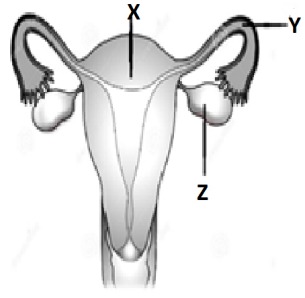
Figure B.
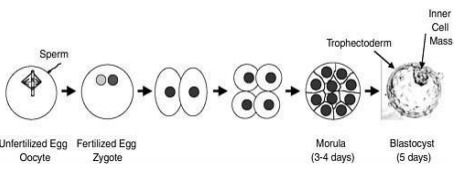
Identify the correct stage of development of human embryo (Figure B) that takes place
at the site X, Y and Z respectively in the human female reproductive system (Figure
A).
Choose the correct option from the table below:
| X | Y | Z | |
|---|---|---|---|
| A | Morula | Fertilized egg | Blastocyst |
| B | Unfertilized egg | Fertilized egg | Morula |
| C | Blastocyst | Fertilized egg | Unfertilized egg |
| D | Fertilized egg | Morula | Blastocyst |
The correct answer is C. blastocyst, Fertilized egg, Unfertilized egg
8. Penetration of the sperm in the ovum is followed by
- formation of first polar body.
- completion of meiosis II.
- first meiosis.
- dissolution of zona pellucida.
The correct answer is completion of meiosis II.
9. The correct sequence of hormone secretion from beginning of menstruation is
- FSH, progesterone, estrogen.
- estrogen, FSH, progesterone.
- FSH, estrogen, progesterone.
- estrogen, progesterone, FSH.
The correct answer is FSH, estrogen, progesterone.
10. In the dioecious aquatic plant shown, identify the characteristics of the male flowers that reach the female flowers for pollination:
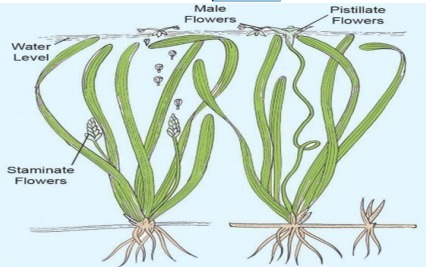
| Size of the flower | Colour of flower | Characteristic feature of pollengrain | |
|---|---|---|---|
| A | small | brightly coloured | Light weight and non-sticky |
| B | large | colourless | large and sticky |
| C | small | white | small, covered with mucilage |
| D | large | colourless | non sticky |
The correct answer is C. small, White, Small, covered with mucilage
11. The thalamus contributes to the fruit formation in
- banana.
- orange.
- strawberry.
- guava.
The correct answer is strawberry.
12. How many types of gametes would be produced if the genotype of a parent is AaBB?
- 1
- 2
- 3
- 4
The correct answer is 2.
13. Which of the following statements indicates parallelism in genes and chromosomes?
- They occur in pairs
- They segregate during gamete formation
- They show linkage
- Independent pairs segregate independently
- (i) and (iii)
- (ii) and (iii)
- (i), (ii) and (iii)
- (i), (ii) and (iv)
The correct answer is (i), (ii) and (iv)
14. Which of the following amino acid substitution is responsible for causing sickle cell anemia?
- Valine is substituted by Glutamic acid in the α globin chain at the sixth position
- Valine is substituted by Glutamic acid in the β globin chain at seventh position
- Glutamic acid is substituted by Valine in the α globin chain at the sixth position
- Glutamic acid is substituted by Valine in the β globin chain at the sixth position
The correct answer is Glutamic acid is substituted by Valine in the β globin chain at the sixth position
15. In human beings, where genotype AABBCC represents dark skin colour, aabbcc represents light skin colour and AaBbCc represents intermediate skin colour; the pattern of genetic inheritance can be termed as:
- Pleiotropy and codominance
- Pleiotropy and incomplete dominance
- Polygenic and qualitative inheritance
- Polygenic and quantitative inheritance
The correct answer is Polygenic and quantitative inheritance
16. Which of the following combination of chromosome numbers represents the correct sex determination pattern in honey bees?
- Male 32, Female 16
- Male 16, Female 32
- Male 31, Female 32
- Female 32, Male 31
The correct answer is Male 16, Female 32
17. Rajesh and Mahesh have defective haemoglobin due to genetic disorders. Rajesh has too few globin molecules while Mahesh has incorrectly functioning globin molecules.Identify the disorder they are suffering from.
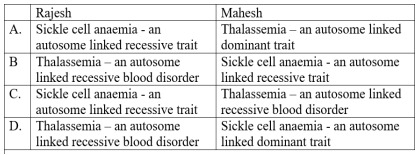
The correct answer is B
18. Which of the following criteria must a molecule fulfil to act as a genetic material?
- It should not be able to generate its replica
- It should chemically and structurally be stable
- It should not allow slow mutation
- It should be able to express itself in the form of Mendelian Characters
- (i) and (ii)
- (ii) and (iii)
- (iii) and (iv)
- (ii) and (iv)
The correct answer is (ii) and (iv)
19. The promoter site and the terminator site for transcription are located at
- 3′ (downstream) end and 5′ (upstream) end, respectively of the transcription unit
- 5′ (upstream) end and 3′ (downstream) end, respectively of the transcription unit
- the 5′ (upstream) end of the transcription unit
- the 3′ (downstream) end of the transcription unit
The correct answer is 5′ (upstream) end and 3′ (downstream) end, respectively of the transcription unit
20. Which of the following is correct about mature RNA in eukaryotes?
- Exons and introns do not appear in the mature RNA.
- Exons appear, but introns do not appear in the mature RNA.
- Introns appear, but exons do not appear in the mature RNA.
- Both exons and introns appear in the mature RNA.
The correct answer is Exons appear, but introns do not appear in the mature RNA.
21. In E.coli, the lac operon gets switched on when
- lactose is present and it binds to the repressor.
- repressor binds to operator.
- RNA polymerase binds to the operator.
- lactose is present and it binds to RNA polymerase.
The correct answer is lactose is present and it binds to the repressor.
22. Oswald Avery, Colin MacLeod and Maclyn McCarty used enzymes to purify biochemicals such as proteins, DNA and RNA from the heat-killed S cells to see which ones could transform live R cells into S cells in Griffith's experiment. They observed that
- Proteases and RNases affected transformation.
- DNase inhibited transformation.
- Proteases and Lipases affected transformation.
- RNases inhibited transformation.
The correct answer is DNase inhibited transformation.
23. AUG on the mRNA will result in the activation of which of the following RNA having correct combination of amino acids:
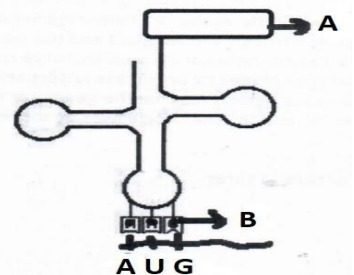
| Site A | Site B | |
|---|---|---|
| A | UAC | Methionine |
| B | Methionine | UAC |
| C | Methionine | AUG |
| D | AUG | Methionine |
The correct answer is Methionine, UAC
24. Short stretches of DNA used to identify complementary sequence in a sample arecalled
- probes
- markers
- VNTRs
- primers
The correct answer is probes
SECTION B
Section - B consists of 24 questions (Sl. No.25 to 48). Attempt any 20 questions fromthis section. The first attempted 20 questions would be evaluated.
Question No. 25 to 28 consist of two statements – Assertion (A) and Reason (R). Answer these questions selecting the appropriate option given below:
- Both A and R are true and R is the correct explanation of A
- Both A and R are true and R is not the correct explanation of A
- A is true but R is false
- A is False but R is true
25. Assertion: Lactational amenorrhea is the natural method of contraception.
Reason: It increases the phagocytosis of sperm.
The correct answer is A is true but R is false
26. Assertion: Saheli, an oral contraceptive for females, contains a steroidal preparation.
Reason: It is a "once a week" pill with very few side effects.
The correct answer is A is False but R is true.
27. Assertion: Parturition is induced by a complex neuro endocrine meachanism.
Reason: At the end of gestation period, the maternal pituitary releases prolactin which
causes uterine contractions.
The correct answer is A is true but R is False.
28. Assertion: When the two genes in a dihybrid cross are situated on the same
chromosome, the proportion of parental gene combinations is much higher than nonparental type.
Reason: Higher parental gene combinations can be attributed to crossing over
between two genes.
The correct answer is A is true but R is false
29. Concentration of which of the following substances will decrease in the maternal blood as it flows from embryo to placenta through the umbilical cord?
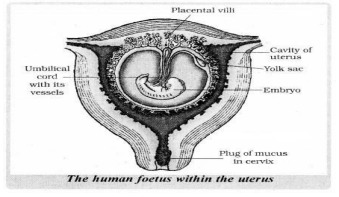
- Oxygen
- Amino Acids
- Carbon dioxide
- Urea
- i and ii
- ii and iv
- iii and iv
- i and iv
The correct answer is i and ii
30. In a fertilized ovule, n, 2n and 3n conditions occur respectively in
- antipodal, zygote and endosperm
- zygote, nucellus and endosperm
- endosperm, nucellus and zygote.
- antipodals, synergids and integusments
The correct answer is antipodal, zygote and endosperm
31. A botanist studying Viola (common pansy) noticed that one of the two flower types withered and developed no further due to some unfavorable condition, but the other flower type on the same plant survived and it resulted in an assured seed set. Which of the following will be correct?
- The flower type which survived is Cleistogamous and it always exhibits autogamy
- The flower type which survived is Chasmogamous and it always exhibits geitonogamy.
- The flower type which survived is Cleistogamous and it exhibits both autogamy and geitonogamy.
- The flower type which survived is Chasmogamous and it never exhibits autogamy
The correct answer is The flower type which survived is Cleistogamous and it always exhibits autogamy
32. During parturition, a pregnant woman is having prolonged labour pains and child birth has to be fastened. It is advisable to administer a hormone that can
- increase the metabolic rate.
- release glucose in the blood.
- stimulate the ovary.
- activate smooth muscles
The correct answer is activate smooth muscles
33. A female undergoing IVF treatment has blocked fallopian tubes. The technique by which the embryo with more than 8 blastomeres will be transferred into the female for further development is
- ZIFT
- GIFT
- IUT
- AI
The correct answer is IUT
34. The mode of action of the copper ions in an IUD is to
- increase the movement of sperms.
- decrease the movement of the sperms.
- make the uterus unsuitable for implantation.
- make the cervix hostile to the sperms.
The correct answer is decrease the movement of the sperms.
35. To produce 400 seeds, the number of meiotic divisions required will be
- 400
- 200
- 500
- 800
The correct answer is 500
36. A cross is made between tall pea plants having green pods and dwarf pea plants having yellow pods. In the F2 generation, out of 80 plants how many are likely to be tallplants?
- 15
- 20
- 45
- 60
The correct answer is 60
37. In Antirrhinum, RR is phenotypically red flowers, rr is white and Rr is pink. Select the correct phenotypic ratio in F1 generation when a cross is performed between RR X Rr:
- 1 red: 2 Pink: 1 white
- 2 Pink: 1 white
- 2 Red: 2 Pink
- All Pink
The correct answer is 2 Red: 2 Pink
38. What would be the genotype of the parents if the offspring have the phenotypes in 1:1 proportion?
- Aa X Aa
- AA X AA
- Aa X AA
- Aa x aa
The correct answer is Aa x aa
39. What is the pattern of inheritance in the above pedigree chart?
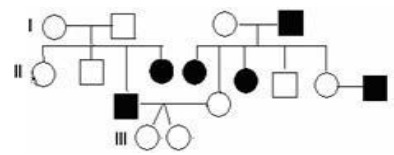
- Autosomal dominant
- Autosomal recessive
- Sex -linked dominant
- Sex -linked recessive
The correct answer is Autosomal recessive
40. A couple has two daughters. What is the probability that the third child will also be a female?
- 25%
- 50%
- 75%
- 100%
The correct answer is 50%
41. Genotypic ratio of 1:2:1 is obtained in a cross between
- AB X AB
- Ab X Ab
- Ab X ab
- ab X ab
The correct answer is Ab X Ab
42. Total number of nucleotide sequences of DNA that codes for a hormone is 1530. The proportion of different bases in the sequence is found to be Adenine = 34%, Guanine = 19%, Cytosine = 23%, Thymine = 19%.
Applying Chargaff’s rule, what conclusion can be drawn?
- It is a double stranded circular DNA.
- It is a single stranded DNA.
- It is a double stranded linear DNA.
- It is a single stranded DNA coiled on Histones.
The correct answer is It is a single stranded DNA.
43. A stretch of an euchromatin has 200 nucleosomes. How many bp will there be in the stretch and what would be the length of the typical euchromatin?
- 20,000 bp and 13,000 x10-9 m
- 10,000 bp and 10,000 x10-9 m
- 40,000 bp and 13,600 x10-9 m
- 40,000 bp and 13,900 x10-9 m
The correct answer is 40,000 bp and 13,600 x10-9 m
44. Observe structures A and B given below. Which of the following statements are correct?
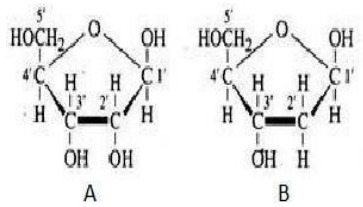
- A is having 2'-OH group which makes it less reactive and structurally stable, whereas B is having 2'-H group which makes it more reactive and unstable.
- A is having 2'-OH group which makes it more reactive and structurally unstable, whereas B is having 2'-H group which makes it less reactive and structurally stable.
- A and B both have -OH groups which make it more reactive and structurally stable.
- A and B both are having -OH groups which make it less reactive and structurally stable
The correct answer is A is having 2'-OH group which makes it more reactive and structurally unstable, whereas B is having 2'-H group which makes it less reactive and structurally stable.
45. If Meselson and Stahl's experiment is continued for sixth generations in bacteria, the ratio of Heavy strands 15N/15N :Hybrid15N/14N : light 14N/14N containing DNA in the sixth generation would be
- 1:1:1
- B. 0:1:7
- 0:1:15
- 0:1:31
The correct answer is 0:1:31
46. Two important RNA processing events lead to specialized end sequences in most human mRNAs: (i) at the 5’ end, and (ii) at the 3’ end. At the 5’end the most distinctive specialized end nucleotide, (iii) is added and a sequence of about 200 (iv) is added to the 3’ end.
- (i) Initiator codon (ii) Promotor (iii) Terminator codon (iv) Release factors
- (i). Promotor (ii) Elongation (iii) Regulation (iv) Termination.
- (i) Capping (ii) Polyadenylation (iii) mGppp (iv) Poly(A).
- (i) Repressor (ii) Co repressor (iii) Operon (iv) sRelease factors
- 10-40 bp sized small sequences within the genes
- Short coding repetitive region on the eukaryotic genome
- Short non-coding repetitive sequence forming large portion of eukaryotic genome
- Regions of coding strands of the DNA
- All of the children
- Children 2, 3 & 6
- Children 1 & 3
- Children 2 & 4
- estrogen
- progesterone
- luteinizing hormone
- follicle stimulating hormone
- estrogen
- progesterone
- luteinizing hormone
- follicle stimulating hormone
- Peak of Hormone B will be observed at a higher point in the graph
- Peak of Hormone B will be observed at a point lower than what is given in the graph
- There will be no observed data for Hormone B
- The graph for Hormone B will be a sharp rise followed by a plateau
- Corpus Luteum
- Tertiary follicle
- Graafian follicle
- Primary follicle
- 28 days
- 42 days
- 180 days
- 280 days
- Subject 1 is pregnant
- Subject 2 is pregnant
- Both subject 1 and 2 are pregnant
- Both subject 1 and 2 are not pregnant
- .IBIB
- .IAi
- .IBi
- .IAIB
- ii
- i, ii, iii, v
- ii, iii ,iv, v
- iii, iv, v
- iv, iii, i
- Normal human female
- Person is suffering from Colour Blindness
- Affected individual is a female with Down’s syndrome
- Affected individual is a female with Turner’s syndrome
- 1:2:1 because of linkage of genes
- 9:3:3:1 because of recombination of genes
- Deviation from 9:3:3:1 ratio because of segregation of genes
- Deviation from 9:3:3:1 ratio because of linkage of genes
- DNA Replication
- Translation - Initiation
- Translation - Elongation
- Translation – Termination
- (i)- discontinuous synthesis , (ii)- continuous synthesis (iii) 3’ end (iv) 5’end
- (i)- continuous synthesis , (ii)- discontinuous synthesis (iii) 5’ end (iv) 3’end
- (i)- discontinuous synthesis, (ii)- continuous synthesis (iii) 5’ end (iv) 3’end
- (i)- continuous synthesis , (ii)- discontinuous synthesis (iii) 3’ end (iv) 5’end
- (i) Promoter Site, (ii) Rho factor (iii) RNA polymerase
- (i) Terminator Site, (ii) Sigma factor (iii) RNA polymerase
- (i) Promoter Site, (ii) Sigma factor (iii) RNA polymerase
- (i) Promoter Site, (ii) Sigma factor (iii) DNA polymerase
The correct answer is (i) Capping (ii) Polyadenylation (iii) mGppp (iv) Poly(A).
47. What are minisatellites?
The correct answer is Short non-coding repetitive sequence forming large portion of eukaryotic genome
48. There was a mix-up at the hospital after a fire accident in the nursery division. Which of these children belong to the parents?
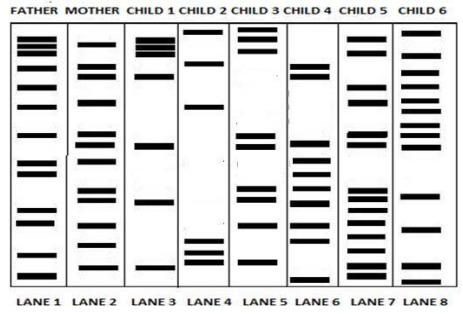
The correct answer is Children 1 & 3
SECTION C
Section-C consists of one case followed by 6 questions linked to this case (Q.No.49 to 54). Besides this, 6 more questions are given. Attempt any 10 questions in this section. The first attempted 10 questions would be evaluated.
Case
To answer the questions, study the graphs below for Subject 1 and 2 showingdifferent levels of certain hormones.
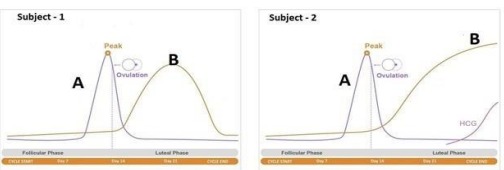
49. The peak observed in Subject 1 and 2 is due to
The correct answer is luteinizing hormone
50. Subject 2 has higher level of hormone B, which is
The correct answer is progesterone
51. If the peak of Hormone A does not appear in the study for Subject 1, which of the following statement is true?
The correct answer is There will be no observed data for Hormone B
52. Which structure in the ovary will remain functional in subject 2?
The correct answer is Corpus Luteum
53. For subject 2 it is observed that the peak for hormone B has reached the plateau stage. After approximately how much time will the curve for hormone B descend?
The correct answer is 280 days
54. Which of the following statements is true about the subjects?
The correct answer is Subject 2 is pregnant
55. The gene that controls the ABO blood group system in human beings has three alleles -IA, IBand i. A child has blood group O. His father has blood group A and mother has blood group B. Genotypes of other off springs can be:
The correct answer is ii, iii ,iv, v
56. Placed below is a karyotype of a human being..
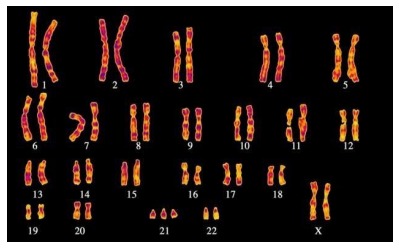
On the basis of this karyotype, which of the following conclusions can be drawn:
The correct answer is Affected individual is a female with Down’s syndrome
57. Given below is a dihybrid cross performed on Drosophila.
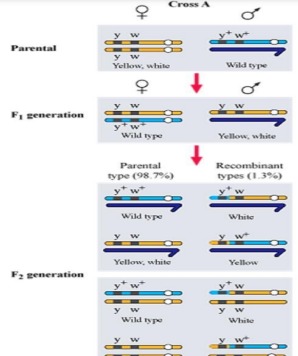
Which of the following conclusions can be drawn on the basis of this cross? When yellow bodied (y), white eyed (w) Drosophila females were hybridized with brown bodied (y+), red eyed males (w+) and F1 progenies were intercrossed, F2 generation would have shown the following ratio:
The correct answer is Deviation from 9:3:3:1 ratio because of linkage of genes
58. Which cellular process is shown below?
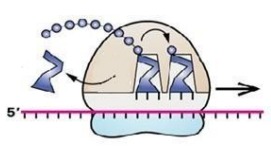
The correct answer is Translation - Elongation
59. Origin of replication of DNA in E. coli is shown below, Identify the labelled parts (i),(ii), (iii) and (iv)
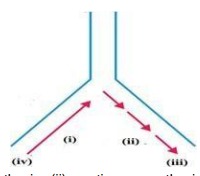
The correct answer is (i)- continuous synthesis , (ii)- discontinuous synthesis (iii) 3’ end (iv) 5’end
60. Transcription unit is represented in the diagram given below.

Identify site (i), factor (ii) and Enzyme (iii) responsible for carrying out the process.
The correct answer is (i) Promoter Site, (ii) Sigma factor (iii) RNA polymerase.
Last Updated on : August 27, 2025
